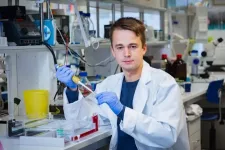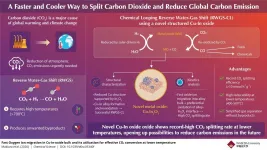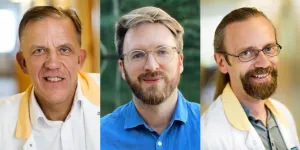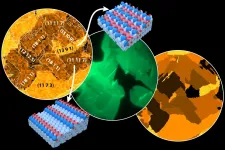(Press-News.org) It is politically agreed and necessary for climate protection reasons that our entire economy becomes climate-neutral in the coming decades - and that applies to air travel, too. This is a technically feasible goal, and there are numerous ways to achieve it. ETH Professor Marco Mazzotti and his team have now compared the options that appear to be the easiest to implement in the short and medium term and evaluated them according to factors such as cost-effectiveness.
The ETH researchers conclude that the most favourable option is to continue powering aircraft with fossil fuels in future, but then remove the associated CO2 emissions from the atmosphere using CO2 capture plants and store that CO2 permanently underground (carbon capture and storage, CCS). "The necessary technology already exists, and underground storage facilities have been operating for years in the North Sea and elsewhere," says Viola Becattini, a postdoc in Mazzotti's group and the study's first author.
"The approach may become a cost-competitive mitigation solution for air travel in case, for example, a carbon tax or a cap-and-trade system were imposed on emissions from fossil jet fuels, or if governments were to provide financial incentives for deploying CCS technologies and achieving climate goals," says ETH professor Mazzotti.
Directly or indirectly from the air
Basically, there are two ways to capture CO2: either directly from the air or indirectly at a site where organic material is burned, for example in a waste incineration plant. "Roughly speaking, half of the carbon in the waste burned in municipal incinerators comes from fossil sources, such as plastic that has been produced from petroleum. The other half is organic material, such as wood or wood products like paper and cardboard," Mazzotti says.
From a climate action perspective, capturing and storing the share of carbon that has fossil origin is a zero-sum game: it simply sends carbon that originated underground back to where it came from. As to the share of carbon from organic sources, this was originally absorbed from the air as CO2 by plants, so capturing and storing this carbon is an indirect way to remove CO2 from the air. This means CCS is a suitable method for putting carbon from fossil aviation fuels back underground - and effectively making air travel carbon-neutral.
In their study, the ETH scientists were able to show that indirect carbon capture from waste incineration gases costs significantly less than direct carbon capture from the air, which is also already technically feasible.
Synthetic fuels more expensive
As a further option, the scientists investigated producing synthetic aviation fuel from CO2 captured directly or indirectly from the air (carbon capture and utilisation, CCU). Because the chemical synthesis of fuel from CO2 is energy-intensive and therefore expensive, this approach is in any case less economical than using fossil fuel and CCS. Regardless of whether the CO2 is captured directly or indirectly, CCU is about three times more expensive than CCS.
ETH Professor Mazzotti also points out one of CCU's pitfalls: depending on the energy source, this approach may even be counterproductive from a climate action perspective, namely if the electricity used to produce the fuel is from fossil fuel-fired power plants. "With Switzerland's current electricity mix or with France's, which has a high proportion of nuclear power, energy-intensive CCU is already more harmful to the climate than the status quo with fossil aviation fuels - and even more so with the average electricity mix in the EU, which has a higher proportion of fossil fuel-fired power plants," Mazzotti says. The only situation in which CCU would make sense from a climate action perspective is if virtually all the electricity used comes from carbon-neutral sources.
More profitable over time
"Despite this limitation and the fundamentally high cost of CCU, there may be regions of the world where it makes sense. For example, where a lot of renewable electricity is generated and there are no suitable CO2 storage sites," Becattini says.
The ETH researchers calculated the costs of the various options for carbon-neutral aviation not only in the present day, but also for the period out to 2050. They expect CCS and CCU technologies to become less expensive both as technology advances and through economies of scale. The price of CO2 emissions levied as carbon taxes is likely to rise. Because of these two developments, the researchers expect CCS and CCU to become more profitable over time.
Infrastructure required
The researchers emphasise that there are other ways to make air travel carbon-neutral. For instance, there is much research underway into aircraft that run on either electricity or hydrogen. Mazzotti says that while these efforts should be taken seriously, there are drawbacks with both approaches. For one thing, electrically powered aircraft are likely to be unsuitable for long-haul flights because of how much their batteries will weigh. And before hydrogen can be used as a fuel, both the aircraft and their supply infrastructure will have to be completely developed and built from scratch. Because these approaches are currently still in the development stage, with many questions still open, the ETH scientists didn't include them in their analysis and instead focused on drop-in liquid fuels.
However, the researchers emphasise that CCS, too, requires infrastructure. The places where CO2 can be captured efficiently and where it can be stored may be far apart, making transport infrastructure for CO2 necessary. Science, industry and politics will have to work hard in the coming years to plan and build this infrastructure - not only for CO2 from aviation, but also for emissions from other carbon-intensive sectors such as chemicals or cement.
INFORMATION:
Fuchs' corneal dystrophy is one of the most common eye diseases diagnosed in almost 5% of the population of Europe aged 40 years or over. It is a hereditary eye disease that causes vision impairment and typically manifests in middle age. The first symptoms of the disease - blisters on the surface of your cornea - resemble cataract at first glance. The disease progresses from the centre of the cornea affecting all layers of the cornea. The progression of the disease varies from individual to individual and in severe cases results in vision loss.
The molecular neurobiology ...
With ever-worsening climate change, there is a growing need for technologies that can capture and use up the atmospheric CO2 (carbon dioxide) and reduce our carbon footprint. Within the realm of renewable energy, CO2-based e-fuels have emerged as a promising technology that attempts to convert atmospheric CO2 into clean fuels. The process involves production of synthetic gas or syngas (a mixture of hydrogen and carbon monoxide (CO)). With the help of the reverse water-gas shift (RWGS) reaction, CO2 is broken down into the CO necessary for syngas. While promising in its conversion efficiency, the RWGS reaction requires incredibly high temperatures (>700°C) to proceed, while also generating ...
In a new study, researchers at Karolinska Institutet in Sweden have used a urine test to identify and verify a patient's type of asthma. The study, which has been published in the American Journal of Respiratory and Critical Care Medicine, lays the foundation for a more personalized diagnosis and may result in improved treatment of severe asthma in the future.
About 10 percent of the Swedish population suffers from asthma, a disease that has become increasingly widespread over the past 50 years, with annual global mortality of around 400,000 according to the World Health Organization. Asthma is characterized by chronic inflammation in the airways, which can result in symptoms including ...
In three recent publications in Molecular Psychiatry, Brain and JAMA Neurology researchers from the University of Gothenburg provide convincing evidence that an in-house developed blood test for Alzheimer's disease can detect the disease early and track its course, which has major implications for a potential use in clinical practice and treatment trials.
"This is an extremely dynamic research field right now, thanks to the technological development and seminal scientific progress in the past years. The dream scenario is to have a blood test for the early detection and screening of Alzheimer's disease up and running. That would give significantly ...
Workaholism or work addiction risk is a growing public health concern that can lead to many negative mental and physical health outcomes such as depression, anxiety or sleep disorder. Perception of work (job demands and job control) may become a major cause of employees' work addiction. The international group of researchers including the HSE University scientist explored the link between work addiction risk and health-related outcomes using the framework of Job Demand Control Model. The results were published in the International Journal of Environmental Research and Public Health.
Workaholics are people who usually work seven and more hours more than ...
Optical sensors can quantitatively analyze chemical and biological samples by measuring and processing the optical signals produced by the samples. Optical sensors based on infrared absorption spectroscopy can achieve high sensitivity and selectivity in real time, and therefore play a crucial role in a variety of application areas such as environmental sensing, medical diagnostics, industrial process control and homeland security.
In a new paper published in Light: Science & Applications, a team of scientists, led by Dr. Peter Q. Liu from the Department of Electrical Engineering, the State University of New York at Buffalo, have demonstrated a new type of high-performance optical sensor which can utilize ...
Metal surfaces play a role as catalysts for many important applications - from fuel cells to the purification of car exhaust gases. However, their behaviour is decisively affected by oxygen atoms incorporated into the surface.
This phenomenon has been known for a long time, but until now it has not been possible to precisely investigate the role of oxygen in complex surfaces point by point in order to understand the chemical background at the atomic level. This has now been achieved at TU Wien in cooperation with a team from the Elettra Synchrotron in Trieste. It became possible ...
A remarkable prediction of Einstein's theory of general relativity--the theory that connects space, time, and gravity--is that rotating black holes have enormous amounts of energy available to be tapped.
For the last 50 years, scientists have tried to come up with methods to unleash this power. Nobel physicist Roger Penrose theorized that a particle disintegration could draw energy from a black hole; Stephen Hawking proposed that black holes could release energy through quantum mechanical emission; while Roger Blandford and Roman Znajek suggested electromagnetic ...
Irvine, Calif., Jan. 11, 2021 - Often admired for their flawless appearance to the naked eye, crystals can have defects at the nanometer scale, and these imperfections may affect the thermal and heat transport properties of crystalline materials used in a variety of high-technology devices.
Employing newly developed electron microscopy techniques, researchers at the University of California, Irvine and other institutions have, for the first time, measured the spectra of phonons - quantum mechanical vibrations in a lattice - at individual crystalline faults, and they discovered the propagation of phonons near the flaws. The team's findings are the subject of a study published recently in Nature.
"Point defects, dislocations, stacking ...
Irvine, Calif., Jan. 5, 2021 -- Scientists at the University of California, Irvine have developed a new deep-learning framework that predicts gene regulation at the single-cell level.
Deep learning, a family of machine-learning methods based on artificial neural networks, has revolutionized applications such as image interpretation, natural language processing and autonomous driving. In a study published recently in Science Advances, UCI researchers describe how the technique can also be successfully used to observe gene regulation at the cellular level. Until now, that process had ...






